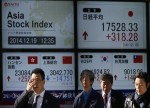
- All Instrument Types
- Indices
- Equities
- ETFs
- Funds
- Commodities
- Currencies
- Crypto
- Bonds
- Certificates
Please try another search

The Most Important Chart In The World Is About To Break Higher

Originally published by AxiTrader
Key Takeaway
US 10 year bonds hit a high of 2.6% in mid-December before rallying all the way back to the very low 2.30% region a month later. Since then prices have mapped out an interesting pennant formation which is at risk of breaking up to continue the bond sell off.
That's particularly the case after Fed chair Janet Yellen, to my mind at least, put a March rate hike in play with her testimony to the Senate last night. Indeed those words saw US 10's rise to 2.47% - up 12 points in the past week.
But what does a potential bond breakout mean for other markets.
What You Need To Know
I don't believe Janet Yellen is necessarily a dove. I believe she has been a dove because that is what the US economy needed during her tenure until recently. And it is what was needed under Ben Bernanke in his post-GFC tenure as Fed chair.
But as the economic outlook has evolved so too has the Fed chair.
So her more hawkish tone in speeches this year and in her testimony to the Senate Banking Committee last night seems to me like one of the world's best economists, and Fed leader, pragmatically changing tack as the winds changed and economic outlook improved.
Specifically Yellen said (my emphasis):
“At its meeting that concluded early this month, the Committee left the target range for the federal funds rate unchanged but reiterated that it expects the evolution of the economy to warrant further gradual increases in the federal funds rate to achieve and maintain its employment and inflation objectives. As I noted on previous occasions, waiting too long to remove accommodation would be unwise, potentially requiring the FOMC to eventually raise rates rapidly, which could risk disrupting financial markets and pushing the economy into recession. Incoming data suggest that labor market conditions continue to strengthen and inflation is moving up to 2 percent, consistent with the Committee’s expectations. At our upcoming meetings, the Committee will evaluate whether employment and inflation are continuing to evolve in line with these expectations, in which case a further adjustment of the federal funds rate would likely be appropriate.”
My sense is that this "new" hawkishness is underappreciated by traders and investors who have potentially missed a clear signal from the Fed chair that a March rate hike is possible.
It is against this backdrop, or this outlook where Yellen is flagging rate hikes ahead, that US 10's are now sitting just below a potential breakout level.

With Yellen reiterating what Stanley Fischer said over the weekend - that the Fed will be guided by its mandate even before the addition of Trumponomics stimulus - a break of 2.50% would clearly signal that a move higher - perhaps toward 2.80% measuring the width of this pennant would be chartists projections.
That has mixed impact on other markets.
For forex the clear implication is that policy divergence between the Fed and other central banks drives the US dollar higher. That, as we are seeing again over the past week as rates have risen, puts the euro and yen under pressure given their central banks current policy settings.
The Aussie dollar should outperform given the RBA in not predisposed just now to ease further and given it is upbeat on growth. But sterling really needs data to continue to print in its favour to not be caught in the US dollar's tractor beam.

Gold too should be pressured by the rise in bonds, and the lift in the US dollar. But the transmission mechanism is likely to have some sand in it given we are just a month out from the Dutch election with the French election, and Greek debt crisis also occupying investors minds.
What about stocks?
If the recent moves are any guide then traders and investors are applauding the rise in bonds because it speaks to an improved economic and earnings backdrop.
Yes Trumponomics is important for the expectations of future earnings as well. But for now 10's, the S&P 500, and the S&P/ASX 200 in Australia have risen with the Citibank G10 Economic surprise index.
.

Tying it all together
US 10 year treasuries are poised for a breakout.
If 2.5% break then a run toward 2.8% is on the cards technically. That should buoy the dollar and hurt gold. But it won't necessarily hurt stocks just yet while the data and expectations of Trumponomics tax cuts, regulation reform, and infrastructure spending retain the markets attention.
The closer we get to 3% however the less likely rising bonds are going to be viewed positively refelecting the improved economic outlook.
Have a great day's trading.
Related Articles

Recent headlines appear to have shaken investor sentiment. It’s premature to read too much into a few days of weaker-than-expected survey numbers. More importantly, the latest...

The stock market sold off on a decline in February's Consumer Confidence Index (CCI), confirming a similar decline in February's Consumer Sentiment Index (CSI), which was reported...

The EU’s most costly budgets, bitcoin’s market swings, and rising US bankruptcies. Each week, the Syz investment team takes you through the last seven days in seven charts. 1. The...
Are you sure you want to block %USER_NAME%?
By doing so, you and %USER_NAME% will not be able to see any of each other's Investing.com's posts.
%USER_NAME% was successfully added to your Block List
Since you’ve just unblocked this person, you must wait 48 hours before renewing the block.
I feel that this comment is:
Thank You!
Your report has been sent to our moderators for review




Add a Comment
We encourage you to use comments to engage with users, share your perspective and ask questions of authors and each other. However, in order to maintain the high level of discourse we’ve all come to value and expect, please keep the following criteria in mind:
Perpetrators of spam or abuse will be deleted from the site and prohibited from future registration at Investing.com’s discretion.